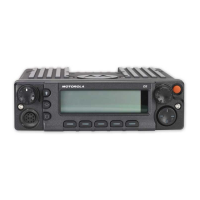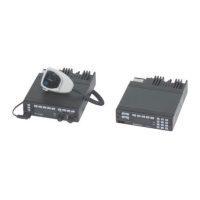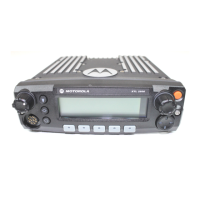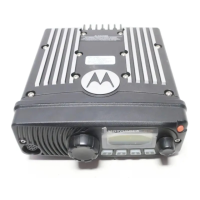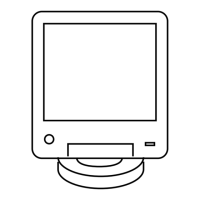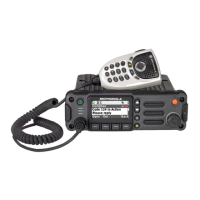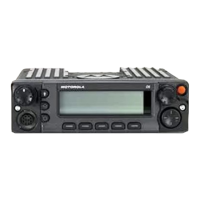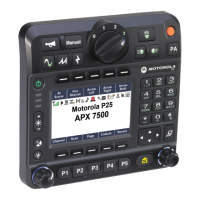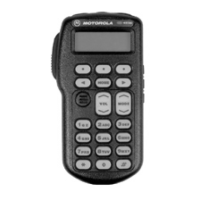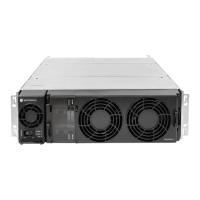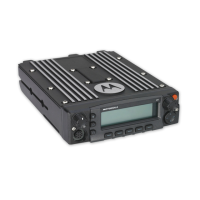May 25, 2005 6881096C74-B
3-76 Theory of Operation: Controller Section
The standard method of upgrading a radio's software and communicating between a computer and
the radio microcontroller involves the use of the UART path via the programming cable. The radio is
placed in a bootstrap mode whenever the programming cable is inserted into either the control- head
microphone connector (P104) or the remote-mount interconnect board data connector (P506). This
cable applies SW_B+ to the MIC_HI line (J0401-4), which forward biases Q0404 and asserts the
CABLE_DET* input low to the Patriot microprocessor. This tells the processor to switch MUX U0401
to route the BOOT_TX line to J0401-25, rather than the default mode, which routes KEYFAIL* to the
pin. This allows the level-shifted BOOT_TX data signal to route directly from the processor's UART
port thru U0308 and out J0401-25 to the microphone/programming connector and to the PC.
On the BOOT_RX side, the CABLE_DET* input also drives BOOT_DATA_EN* low, which switches
off buffers U0303-4 and U0303-3, routing the level-shifted BOOT_RX data from J0401-26 and to the
processor's UART port. This data is level-shifted from 5 V to 2.85 V through U0303-2.
When interfacing with CPS, the TUNER software, and during a flash operation, the control-head
display does not go blank. SB9600 messaging continues and, upon removal of the programming
cable, the radio usually undergoes a reset operation as part of the normal cable detection and
removal process.
High power is different from the mid power radios in several ways. High power is always configured
for remote and on the remote TIB there is a GCAI connector instead of a programming port (P104).
The GCAI connector is the only USB port on a high power “brick” and unlike mid power, it shares
these lines with BOOT_RX and BOOT_TX. For this reason, there is no U0401 MUX and Keyfail is
not shared by any other line. The GCAI standard requires that the type of cables are determined by
a one-wire memory device, so “CABLE_DET” is not connected to the MIC_HI line. On all radios the
default condition of the UART is four-wire RS232 either through the rear J2 connector on mid power
or J6 on the TIB of all remote configurations. For this reason, data cables can also be used with
CPS. High power does not have a rear connector so the only way to access USB is through the
GCAI connector. USB is the default condition of the GCAI, but one-wire is always read any time that
a cable is detected.
Programming high power with a GCAI RS232 cable is done the following way. The cable is detected
by grounding GP1O0 on the GCAI connector and in turn the processor reads the one-wire memory
in the same attached cable. If it determines from one-wire that a two-wire RS232 cable is attached,
GCAI_USB-RS232 is lowered to allow 5 volt power on the TIB to supply current to USB_PWR on the
GCAI and to turn off the passive FET Q801 which normally allows power to be supplied to the USB
interface. On the “brick”, GCAI_USB-RS232 line also drives CABLE_DET and BOOT_DATA_EN*.
This line also drives U0303-2, which has now been enabled to receive BOOT_RX on the USB-line.
With USB_PWR off U0308 is allowed to drive the BOOT_TX on the USB+ line.
3.8.13 Reflashing/Upgrading Firmware
The FLASH IC is the firmware storage IC. Programming this IC is accomplished using one of the
following input paths:
• Two-wire RS-232 directly from a computer’s srial port to the radio’s rear connector data cable
HKN6160 (Mid Power only)
• Two-wire RS-232 through an HKN6155 programming cable at the control head’s 10-pin
microphone port (Mid Power only)
• Two-wire RS-232 through an HKN6155 programming cable at the Remote Mount Interconnect
board’s 10-pin flash port (Mid Power only)
• Two-wire RS-232 through an HKN6183 programming cable at the High Power Remote Mount
Interconnect board’s 10-pin GCAI port (High Power only)
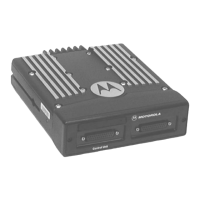
